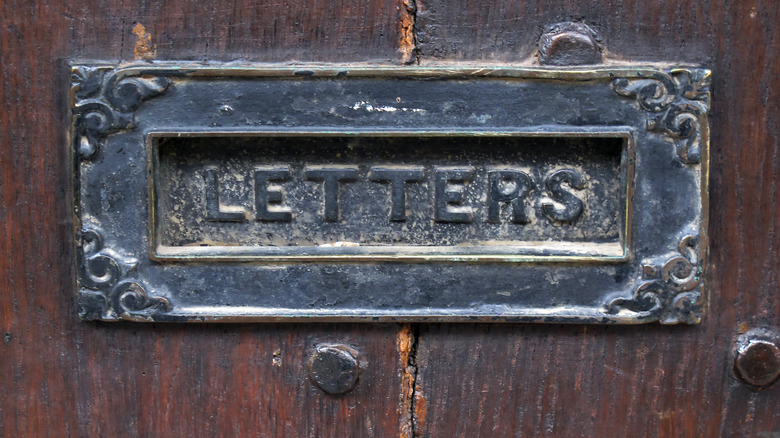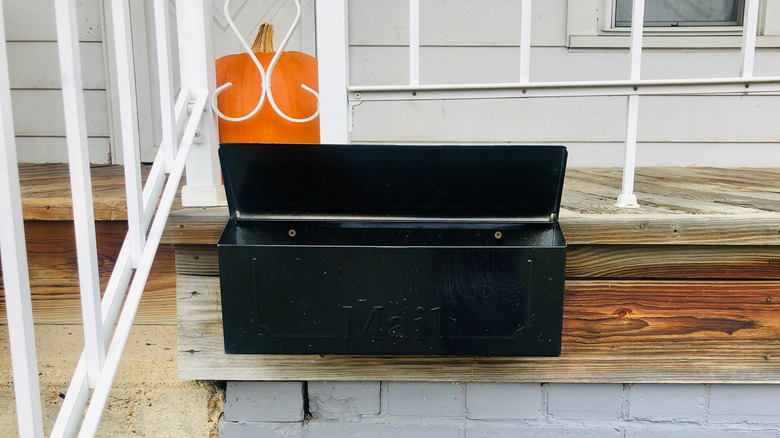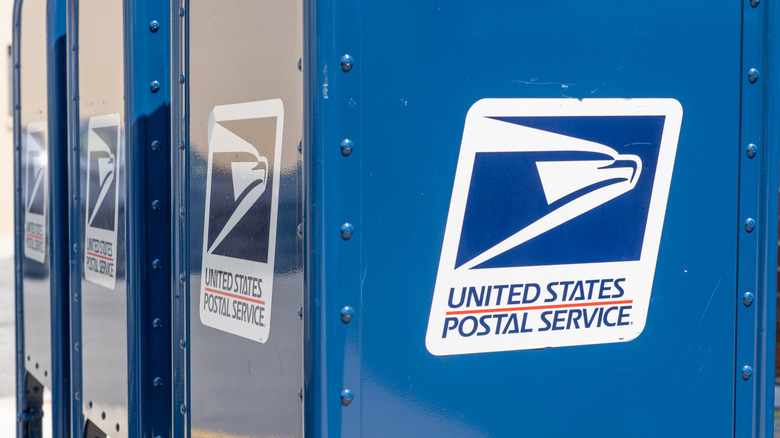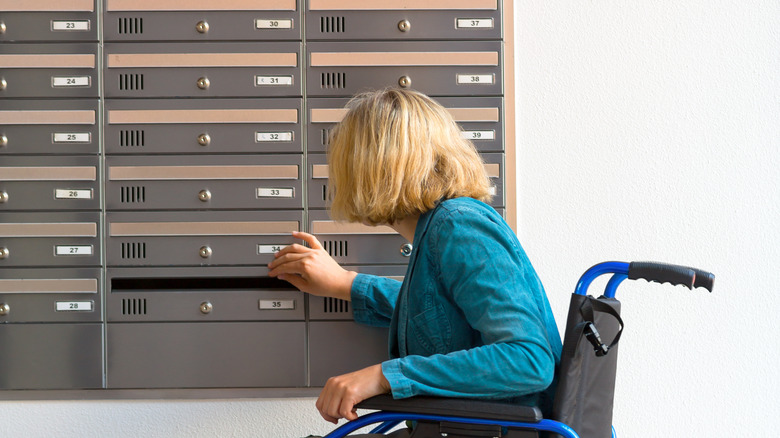The History Of The Mailbox
In the quest to invent the first mailbox, Britain beat the U.S. by far. The British already had something called a letterbox by the mid-19th century, according to a 2017 article by Nate Marks posted on Medium. "Letterbox" was a catch-all phrase to designate something used by households and businesses to receive mail. Sometimes it was an actual box, and other times it was merely a slot in the door (as above). If a box, it had to be large enough to hold letters, and weather-safe to keep them dry and not corrode itself. Thus did the British government regulate the size and composition of letterboxes from 1849 on.
It would be another 100 years or so before the Beatles would pay tribute to the humble British mail receptacle always exposed to the elements, releasing the song "Across the Universe" in 1969 containing the line, "Thoughts meander like a restless wind inside a letterbox." But let's not get ahead of ourselves, because across the pond in the U.S., the rollout of mailboxes was slower and bumpier. Acknowledging that mail travels to all seven continents – including Antarctica – and that mailboxes developed differently all over the world, we'll use the U.S. as a case study for the history of the mailbox.
The need for mailboxes
Prior to mailboxes, everyone went to the post office to pick up mail. This was not convenient for everyone, so the Post Office Department developed a plan to deliver mail to the people's homes, even in the far reaches of rural America. Rural Free Delivery Service (RFD) began on a trial basis in 1896 and became an official service in 1902, according to the National Postal Museum website.
Rural Americans taking part in the new program scrambled to find acceptable mailboxes to receive mail at their homes and farms. Old food containers and empty oil drums like the one pictured above were common, though sometimes not fully cleaned out ahead of time. It became clear to the Post Office Department (predecessor to the U.S. Postal Service) that just as half a century before in England, regulation of mail receptacles was needed. The department began regulating mailboxes in 1901.
Necessity is the mother of invention
It is no surprise some of the early inventors who patented mailboxes were postal workers themselves. Not only did they know the regulations, they also knew what worked best in the field. The specifications for an approved mailbox are the same now as they were in the early 20th century, according to the National Postal Museum. A mailbox needs to be secure, but easy for the letter carrier to open. It needs to be large enough to receive mail, and weather-proof enough to keep the mail dry and not corrode. Finally, it has to be "buggy high," so the postal carrier can deliver the mail straight off the horse-cart, as demonstrated in a short film (posted on YouTube) from the Smithsonian. (This last requirement has been updated for vehicles, but it's the same general idea.)
One example of a successful mailbox, invented back in 1915 for the Rural Free Delivery service, is the RFD Joroleman-style mailbox (pictured above). The designer, Roy Joroleman, was an engineer for the Post Office Department. The novelty of this design lay in its domed roof, which prevented rain and snow from accumulating on the top, allowing the mail inside to stay dry, according to the Mailboxes and Designs Blog. Because of this, the 100-year-old RFD Joroleman-style mailbox is still widely popular for roadside mail delivery.
Waiting on your doorstep
While rural Americans were making sure their roadside mailboxes met all the requirements of the Post Office Department, most Americans living in cities did not have mailboxes yet. According to National Mailboxes, City Free Delivery service had been around even longer than Rural Free Delivery Service — since 1863, to be exact. However, postal carriers delivered on foot and it was their responsibility to knock on each door and wait for someone to answer so they could hand over the mail.
Carriers lost an estimated 90 minutes over the course of their day, time spent waiting on doorsteps, according to the National Postal Museum. Thus in 1923, the Post Office Department required each household to have a mailbox or letter slot where mail could be left. Reminiscent of British letterboxes affixed to the house, the new required mailboxes were also a set height and width, of a design that would keep moisture out, and of a material that would not corrode. Today most household mailboxes are made of aluminum and steel, according to Medium.
The street mailbox
There is another kind of mailbox, the kind that takes your outgoing mail so you don't have to go all the way to the post office. This is the street mailbox, or collection box. This kind of mailbox has been around since 1891, invented by Philip Downing, according to Amazing Black History. Downing was a Black inventor in Rhode Island, the son of an abolitionist who'd helped found the United Anti-Slavery Society of New York.
Downing did not work for the Post Office Department, as did Roy Joroleman; he was an inventor with a variety of interests. He was also known for inventing a train and streetcar switch that eventually led to our present-day light switches. Downing's design for the mailbox was similar to what we see on the street today: a heavy box on legs, with features to protect mail from the weather and keep it secure inside until picked up.
Evolution of the mailbox
Though the mailbox is over 100 years old (and the letterbox even older), it continues to evolve. In 1939, the vertical mailbox was invented by business partners Saulia O. Florence and Herbert Dix, according to the National Postal Museum. The two men had met while working for a mailbox manufacturing company that closed during the Depression. Opening their own company, the Florence Corporation, they came up with a new centralized mailbox for large buildings. The design allowed mail carriers to quickly deliver mail to multiple boxes at once by opening one large door on the top of the mailbox. Mail recipients retrieved their mail from a smaller door on the other side that only they could access.
Another newer invention improves on the old RFD Joroleman-style mailbox, retaining the domed roof, but making the box vertical instead of horizontal. This model, called the Bonbobi, is ADA compliant because it allows for unobstructed wheelchair passage down the sidewalk. Mailboxes will continue to change, to meet changing needs.





